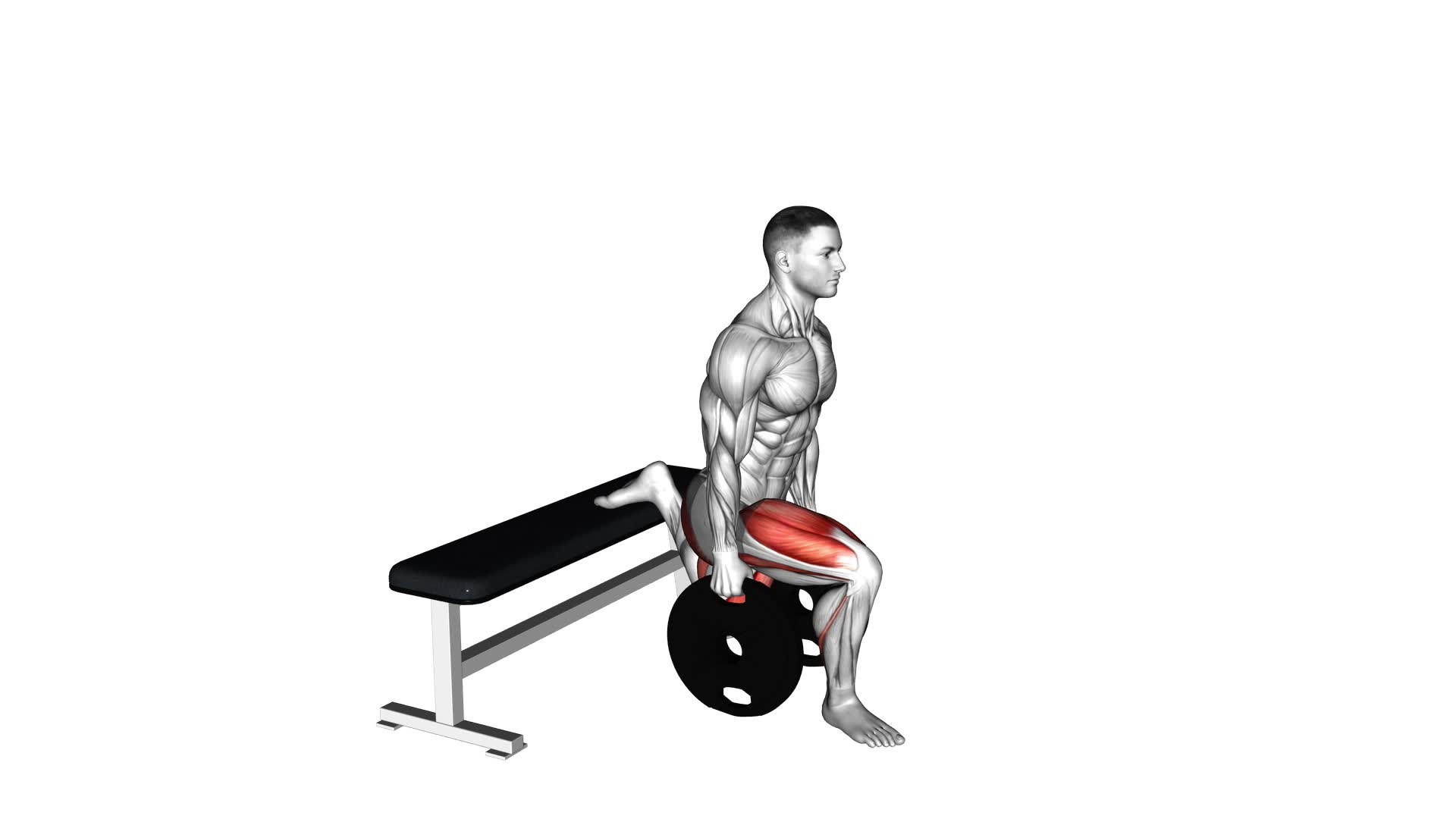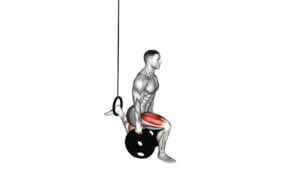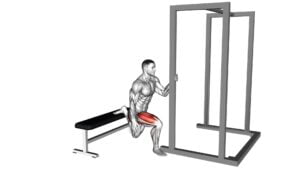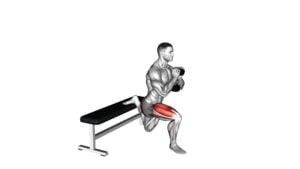Weighted Plates Bulgarian Split Squat – Video Exercise Guide & Tips

Are you looking for a challenging lower body exercise that can help you build strength and improve your stability? Look no further than the Weighted Plates Bulgarian Split Squat.
Watch This Exercise Video
In this video exercise guide, we'll show you how to properly set up and perform this exercise, along with tips to increase intensity and avoid common mistakes.
Get ready to take your leg training to the next level with this effective and efficient workout.
Key Takeaways
- Weighted Plates Bulgarian Split Squat is a highly effective exercise for building strength and stability in the lower body.
- This exercise targets multiple muscle groups, including the quadriceps, hamstrings, glutes, and calves, and activates them to a high degree.
- Incorporating variations of the exercise, such as elevated split squats or dumbbell Bulgarian split squats, adds variety to the workout routine and allows for customization of weight used.
- Proper form and technique, such as maintaining stability and engaging the core, are essential for maximizing benefits and preventing injury during the exercise.
Benefits of the Weighted Plates Bulgarian Split Squat
One major benefit of the weighted plates Bulgarian split squat is that it helps you build strength and stability in your lower body. This exercise specifically targets your quadriceps, hamstrings, glutes, and calves, activating these muscles to a high degree. The weighted plates add an extra challenge, increasing the intensity of the exercise and promoting muscle growth. By performing this exercise regularly, you can significantly improve the strength and endurance of your lower body muscles.
In addition to the muscle activation, there are also variations of the weighted plates Bulgarian split squat that you can incorporate into your workout routine. One variation is the elevated split squat, where you place your front foot on an elevated surface, such as a step or bench. This variation increases the range of motion and places more emphasis on the glutes and hamstrings. Another variation is the dumbbell Bulgarian split squat, where you hold dumbbells in each hand instead of using weighted plates. This variation allows for greater flexibility and customization in terms of the weight used.
Now that you understand the benefits and variations of the weighted plates Bulgarian split squat, let's move on to how to set up for the exercise.
How to Set Up for the Exercise
To set up for the exercise, start by selecting a pair of weighted plates that challenge your lower body muscles. It's important to choose a weight that's appropriate for your fitness level and goals. Common mistakes when setting up for the exercise include using weights that are too heavy or too light, which can compromise your form and effectiveness of the exercise. Make sure the weighted plates are secure and stable before starting the exercise to prevent any accidents or injuries.
Modifications can be made to accommodate different fitness levels and needs. If you're a beginner or have difficulty balancing, you can start by using bodyweight only or holding onto a stable object for support. As you progress, you can gradually add weight and work towards performing the exercise without assistance.
Proper Form and Technique for the Weighted Plates Bulgarian Split Squat
To perform the weighted plates Bulgarian split squat with proper form and technique, you should position yourself in a stable stance with your feet hip-width apart. This exercise is commonly performed with dumbbells, but using weighted plates adds an extra challenge. One common misconception is that you need to have a high level of flexibility to perform this exercise, but that isn't true. As long as you have enough mobility to perform a regular split squat, you can do the weighted plates variation.
To begin, hold a weighted plate at your chest level with both hands, keeping your elbows tucked in. Take a step forward with one foot and place it far enough in front of you so that when you lower your body, your front knee stays directly above your ankle. Lower your back knee down towards the floor while keeping your torso upright and your core engaged. Push through your front heel to raise your body back up to the starting position. Repeat on the other side.
If you want to try alternative variations, you can hold a weighted plate overhead or even perform the exercise on an elevated surface. These variations can target different muscles and add variety to your routine. Remember to always maintain proper form and technique to maximize the benefits of this exercise and prevent injury.
Tips to Increase Intensity and Difficulty
Increase the intensity and difficulty of the weighted plates Bulgarian split squat by incorporating these tips.
One way to modify the exercise is by increasing the weight of the plates. Adding more weight will challenge your muscles and make the exercise more difficult.
Another way to increase intensity is by performing the exercise at a slower tempo. This will require more control and stability, leading to greater muscle activation.
Additionally, you can try performing the split squat on an unstable surface, such as a balance board or a Bosu ball. This will engage your core muscles even more and enhance the difficulty of the exercise.
Lastly, you can incorporate alternative variations into your routine. For example, you can try performing the split squat with dumbbells instead of weighted plates, or you can incorporate plyometric jumps into the exercise. These variations will add an extra element of challenge and intensity to your workout.
Remember to always listen to your body and progress at a pace that's comfortable for you.
Common Mistakes to Avoid
When performing the weighted plates Bulgarian split squat, be mindful of common mistakes to avoid. Proper alignment is crucial to ensure you get the most out of this exercise and prevent injury.
One common mistake is allowing your knee to go past your toes when lowering into the squat position. This puts excessive strain on your knee joint and can lead to discomfort or injury. To avoid this, focus on keeping your weight in your heel and pushing your hips back as you lower down.
Another mistake to watch out for is rounding your back or hunching your shoulders. This can lead to strain in your lower back and diminish the effectiveness of the exercise. Instead, keep your chest lifted and your shoulders back throughout the movement.
Lastly, be careful not to rush through the exercise. Slow and controlled movements are key to engaging your muscles properly and maximizing the benefits of the weighted plates Bulgarian split squat.
Frequently Asked Questions
How Many Sets and Reps Should I Do for the Weighted Plates Bulgarian Split Squat?
To determine the number of sets and reps for the weighted plates Bulgarian split squat, consider your fitness level and goals. Start with 3 sets of 8-12 reps, resting 1-2 minutes between sets.
This exercise targets your quads, glutes, and hamstrings while improving stability and balance. If you don't have weighted plates, you can use dumbbells or kettlebells as alternatives.
Always consult with a trainer or fitness professional for personalized advice.
Can I Use Dumbbells Instead of Weighted Plates for This Exercise?
Yes, you can definitely use dumbbells instead of weighted plates for the Bulgarian split squat exercise.
This variation of the exercise allows you to work your legs and glutes effectively while holding dumbbells in your hands.
It provides a similar challenge and targets the same muscle groups as the version with weighted plates.
Just make sure to maintain proper form and control throughout the movement to maximize the benefits of the exercise.
Should I Perform This Exercise With Shoes or Barefoot?
To maximize the benefits of the Bulgarian Split Squat, it's recommended to perform this exercise with shoes on. Wearing shoes provides stability and support for your feet, reducing the risk of injury.
However, if you have foot conditions or prefer barefoot training, modifications can be made. Consult with a fitness professional to find alternative options that will accommodate your specific needs while still allowing you to safely perform the exercise.
Can Beginners Perform the Weighted Plates Bulgarian Split Squat?
As a beginner, you may wonder if you can perform the weighted plates Bulgarian split squat. The good news is that this exercise can be modified to suit your fitness level. By starting with lighter weights and gradually increasing the load, you can safely build strength and stability.
The benefits for beginners include improved muscle strength, balance, and coordination. Just remember to focus on proper form and listen to your body to avoid injury.
Is It Necessary to Warm up Before Doing This Exercise?
Before starting any exercise, it's important to warm up to prevent injury and maximize your performance. Incorporating a warm up routine has several benefits, such as increasing blood flow to your muscles and preparing your body for the upcoming workout.
For beginners in the weighted plates Bulgarian split squat, modifications can be made to accommodate their fitness level. Always consult with a professional or trainer to ensure proper form and technique.
Conclusion
In conclusion, the Weighted Plates Bulgarian Split Squat is a highly effective exercise for strengthening the lower body muscles.
By properly setting up and maintaining proper form and technique, individuals can safely and efficiently increase intensity and difficulty.
However, it's important to avoid common mistakes to prevent injury.
Incorporating this exercise into a regular workout routine can lead to improved muscle strength and overall fitness.

Author
Years ago, the spark of my life’s passion ignited in my mind the moment I stepped into the local gym for the first time. The inaugural bead of perspiration, the initial endeavor, the very first surge of endorphins, and a sense of pride that washed over me post-workout marked the beginning of my deep-seated interest in strength sports, fitness, and sports nutrition. This very curiosity blossomed rapidly into a profound fascination, propelling me to earn a Master’s degree in Physical Education from the Academy of Physical Education in Krakow, followed by a Sports Manager diploma from the Jagiellonian University. My journey of growth led me to gain more specialized qualifications, such as being a certified personal trainer with a focus on sports dietetics, a lifeguard, and an instructor for wellness and corrective gymnastics. Theoretical knowledge paired seamlessly with practical experience, reinforcing my belief that the transformation of individuals under my guidance was also a reflection of my personal growth. This belief holds true even today. Each day, I strive to push the boundaries and explore new realms. These realms gently elevate me to greater heights. The unique combination of passion for my field and the continuous quest for growth fuels my drive to break new ground.







